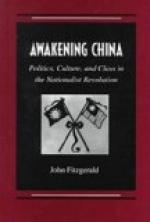Notice on the left those long rows of trees that appear to spring from the bosom of the river. They are the life-belt of the Island of Tsungming which six centuries ago rose like the fabled Delos from the surface of the turbid waters. Accepted as the river’s tribute to the Dragon Throne, it now forms a district of the province with a population of over half a million. About the same time, a large tract of land was carried into the sea by the Hwang Ho, the “Yellow River,” which gave rise to the popular proverb, “If we lose in Tungking we gain in Tsungming.”
[Page 29] The former river comes with its mouth full of pearls; the latter yawns to engulf the adjacent land. At present, however, the Yellow River is dry and thirsty, the unruly stream, the opposite of Horace’s uxorius amnis, having about forty years ago forsaken its old bed and rushed away to the Gulf of Pechili (Peh-chihli). This produced as much consternation as the Mississippi would occasion if it should plough its way across the state that bears its name and enter the Gulf of Mexico at Mobile Bay. The same phenomenon has occurred at long intervals in times past. The wilful stream has oscillated with something like periodical regularity from side to side of the Shantung promontory, and sometimes it has flowed with a divided current, converting that territory into an island. Now, however, the river seems to have settled itself in its new channel, entering the gulf at Yang Chia Kow—a place which foreign sailors describe as “Yankee cow”—and making a portentous alteration in the geography of the globe.
[Page 30] CHAPTER VI
PROVINCE OF SHANTUNG
Kiao-Chao—Visit to Confucius’s Tomb—Expedition to the Jews of K’ai-fung-fu—The Grand Canal—Chefoo
In Shantung the people appear to be much more robust than their neighbours to the south. Wheat and millet rather than rice are their staple food. In their orchards apples, pears and peaches take the place of oranges.
At Kiao-chao (Kiau-Chau) the Germans, who occupied that port in 1897, have built a beautiful town opposite the Island of Tsingtao, presenting a fine model for imitation, which, however, the Chinese are not in haste to copy. They have constructed also a railway from the sea to Tsinan-fu, very nearly bisecting the province. Weihien is destined to become a railroad centre; and several missionary societies are erecting colleges there to teach the people truths that Confucius never knew. More than half a century ago, when a missionary distributed Christian books in that region, the people brought them back saying, “We have the works of our Sage, and they are sufficient for us.” Will not the new arts and sciences of the West convince them that their Sage was not omniscient?
In 1866 I earned the honours of a hadji by visiting the tomb of Confucius—a magnificent mausoleum surrounded by his descendants of the seventieth generation, [Page 31] one of whom in quality of high priest to China’s greatest teacher enjoys the rank of a hereditary duke.




